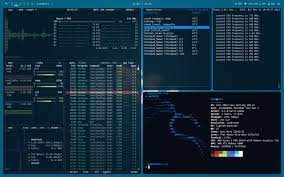Unleashing the Potential of Ubuntu KDE: A Fusion of Power and Elegance
Exploring Ubuntu KDE
Ubuntu KDE is a variant of the popular Ubuntu operating system that features the KDE Plasma desktop environment. Combining the stability and security of Ubuntu with the flexibility and customizability of KDE, this edition offers users a unique and powerful computing experience.
The KDE Plasma desktop is known for its modern and visually appealing interface, rich set of features, and extensive customization options. With Ubuntu KDE, users can enjoy a sleek and intuitive desktop environment that can be tailored to suit individual preferences.
One of the key advantages of Ubuntu KDE is its versatility. Whether you are a casual user looking for a user-friendly interface or a power user seeking advanced customization options, Ubuntu KDE caters to a wide range of needs. From widgets and themes to desktop effects and virtual desktops, KDE Plasma provides users with ample tools to personalize their computing environment.
In addition to its aesthetic appeal, Ubuntu KDE also offers robust performance and seamless integration with Ubuntu’s underlying system. Users can benefit from the reliability and security of Ubuntu while enjoying the flexibility and innovation of the KDE Plasma desktop.
Whether you are new to Linux or a seasoned user looking to explore different desktop environments, Ubuntu KDE presents an exciting opportunity to discover the best of both worlds. Experience the power of Ubuntu combined with the elegance of KDE Plasma – try Ubuntu KDE today!
Comparing Desktop Environments: KDE vs. XFCE and GNOME in Ubuntu
- Which is lighter KDE or XFCE?
- Which is better GNOME or KDE?
- What is KDE in Ubuntu?
- Which is better, KDE or GNOME?
- Is xfce better than KDE?
Which is lighter KDE or XFCE?
When comparing KDE and XFCE in terms of system resource usage, XFCE is generally considered to be lighter than KDE. XFCE is known for its minimalistic design and efficient performance, making it a popular choice for users seeking a lightweight desktop environment that can run smoothly on older hardware or systems with limited resources. On the other hand, while KDE offers a more feature-rich and visually appealing experience with extensive customization options, it tends to be more resource-intensive compared to XFCE. Ultimately, the choice between KDE and XFCE depends on individual preferences and hardware capabilities, with XFCE being favoured for its lightweight nature and KDE for its advanced features and visual aesthetics.
Which is better GNOME or KDE?
The question of whether GNOME or KDE is better is a common one among Linux users, each desktop environment offering its own unique strengths and features. GNOME is known for its simplicity, clean design, and user-friendly interface, making it a popular choice for those who value a streamlined and intuitive desktop experience. On the other hand, KDE is praised for its flexibility, customization options, and extensive set of features, appealing to users who prefer a more personalised and feature-rich desktop environment. Ultimately, the choice between GNOME and KDE comes down to individual preferences and needs – whether you prioritise simplicity and elegance or customizability and functionality. Both desktop environments have their own merits, so it’s worth exploring both to determine which aligns best with your workflow and aesthetic preferences.
What is KDE in Ubuntu?
KDE in Ubuntu refers to the KDE Plasma desktop environment that is available as an alternative to the default GNOME desktop environment in Ubuntu. KDE, short for K Desktop Environment, is a highly customizable and feature-rich desktop environment that offers users a visually appealing interface along with a wide range of tools and applications. When users choose to install Ubuntu with KDE, they are opting for a computing experience that combines the stability and security of Ubuntu with the flexibility and aesthetics of KDE Plasma. This choice allows users to tailor their desktop environment to suit their preferences, whether they are looking for advanced customization options or simply seeking a fresh and modern interface.
Which is better, KDE or GNOME?
When it comes to the debate between KDE and GNOME, the answer ultimately depends on personal preference and individual needs. KDE is known for its flexibility, extensive customizability, and modern interface, making it a popular choice for users who value control over their desktop environment. On the other hand, GNOME offers a more streamlined and user-friendly experience, focusing on simplicity and ease of use. Both desktop environments have their strengths and weaknesses, so the decision between KDE and GNOME boils down to what features and design elements resonate most with each user’s workflow and aesthetic preferences. Ultimately, there is no definitive answer to which is better – it’s about choosing the desktop environment that best suits your unique requirements and enhances your overall computing experience.
Is xfce better than KDE?
When comparing XFCE and KDE desktop environments on Ubuntu, the choice between the two often comes down to personal preference and specific use cases. XFCE is known for its lightweight nature, making it a popular choice for older hardware or users seeking a simple and efficient desktop experience. On the other hand, KDE offers a more feature-rich environment with advanced customisation options and visually appealing effects. While some may argue that XFCE is better for its speed and resource efficiency, others may prefer KDE for its modern interface and extensive set of tools. Ultimately, the decision between XFCE and KDE depends on individual needs and priorities in terms of performance, aesthetics, and functionality.



